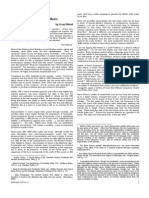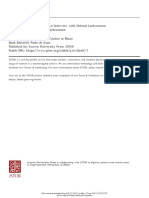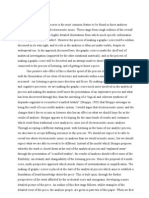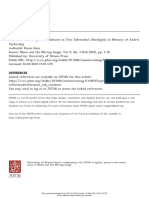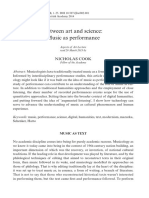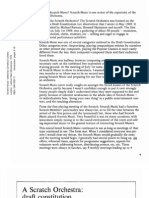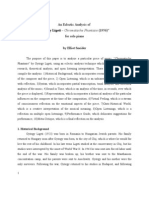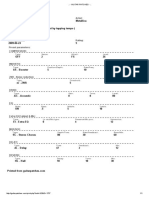100%(1)100% found this document useful (1 vote)
115 viewsMarianthie Makropoulou - Spectral Music Analysis and Reasearch
Marianthie Makropoulou - Spectral Music Analysis and Reasearch
Uploaded by
Marianthie MakropoulouSpectral music developed in France in the 1970s and analyzed sound spectra using Fourier analysis to decompose complex sounds into sine waves. Composers like Grisey and Murail focused on timbre, the overtone series, and slow harmonic development rather than chords or melodies. Spectral music treats pitch and timbre as inseparable aspects of sound. Compositions are based on the evolution of sound spectra over time. Grisey explored difference tones, the dynamic character of sounds, and the perception of multiple layers of time in music and other beings.
Copyright:
© All Rights Reserved
Available Formats
Download as PDF, TXT or read online from Scribd
Marianthie Makropoulou - Spectral Music Analysis and Reasearch
Marianthie Makropoulou - Spectral Music Analysis and Reasearch
Uploaded by
Marianthie Makropoulou100%(1)100% found this document useful (1 vote)
115 views10 pagesSpectral music developed in France in the 1970s and analyzed sound spectra using Fourier analysis to decompose complex sounds into sine waves. Composers like Grisey and Murail focused on timbre, the overtone series, and slow harmonic development rather than chords or melodies. Spectral music treats pitch and timbre as inseparable aspects of sound. Compositions are based on the evolution of sound spectra over time. Grisey explored difference tones, the dynamic character of sounds, and the perception of multiple layers of time in music and other beings.
Original Description:
An essay on contemporary techniques in spectral music
Original Title
Marianthie Makropoulou- Spectral music analysis and reasearch
Copyright
© © All Rights Reserved
Available Formats
PDF, TXT or read online from Scribd
Share this document
Did you find this document useful?
Is this content inappropriate?
Spectral music developed in France in the 1970s and analyzed sound spectra using Fourier analysis to decompose complex sounds into sine waves. Composers like Grisey and Murail focused on timbre, the overtone series, and slow harmonic development rather than chords or melodies. Spectral music treats pitch and timbre as inseparable aspects of sound. Compositions are based on the evolution of sound spectra over time. Grisey explored difference tones, the dynamic character of sounds, and the perception of multiple layers of time in music and other beings.
Copyright:
© All Rights Reserved
Available Formats
Download as PDF, TXT or read online from Scribd
Download as pdf or txt
100%(1)100% found this document useful (1 vote)
115 views10 pagesMarianthie Makropoulou - Spectral Music Analysis and Reasearch
Marianthie Makropoulou - Spectral Music Analysis and Reasearch
Uploaded by
Marianthie MakropoulouSpectral music developed in France in the 1970s and analyzed sound spectra using Fourier analysis to decompose complex sounds into sine waves. Composers like Grisey and Murail focused on timbre, the overtone series, and slow harmonic development rather than chords or melodies. Spectral music treats pitch and timbre as inseparable aspects of sound. Compositions are based on the evolution of sound spectra over time. Grisey explored difference tones, the dynamic character of sounds, and the perception of multiple layers of time in music and other beings.
Copyright:
© All Rights Reserved
Available Formats
Download as PDF, TXT or read online from Scribd
Download as pdf or txt
You are on page 1of 10
Marianthie Makropoulou
Spectral Music;
a brief presentation of a groundbreaking compositional technique, the
study of psychoacoustics and human perception.
Spectral music can be defined as the compositional technique developed in France in
the 1970s which used the mathematical analysis of sound spectra as a compositional
tool and was based on Fourier’s theory, stating that any complex signal can be
decomposed into a sum of sinusoidal waves, over an infinite time frame, by
specifying their relative amplitudes and phrases. That means, concerning the nature
of sound, that a complex tone can be decomposed into a sum of sine tones, called
the “partials” of the sound, the set of which form its spectrum. The knowledge of the
frequency components present in the sound resulted in the birth of the idea of
spectral composition. The spectral music composers of this time (including Gerard
Grisey and Tristan Murail) were greatly interested in the fundamental nature of
sound, in particular, the overtone series. Rather than creating works based on chord
progressions or tone rows, these composers wrote pieces that were constructed on
the development of a sound spectrum and were based on slow harmonic
development, while being devoid of a prominent melody or a strong sense of pulse.
Spectral music replaced the principle of interval sequence and motivic
transformation of western tradition with the principle of fusion and continuity. In
order to understand how spectral music functions in the context of physical reality,
one must bear in mind that a balance between calculation and intuition, theory and
experimentation is essential to music. Thus, the physical reality of spectral music is
characterized by the use of sounds ranging from white noise to sinusoidal tones,
rejecting, in a sense the established equal tempered tonal system.
Crucial to spectralism (and especially in Grisey’s music) is the concept of timbre,
standing at the head of a compositional strategy as the reference point in which
different structural and morphological approaches were applied. The spectral
composition of timbres serves the creation of a new system of pitches based on the
harmonic series and the reconstruction, by acoustic instruments or electronic
sounds, of the structure of certain timbres. It is important to stress that in spectral
music, pitch and timbre are treated not as separate notions, but as different aspects
of the same phenomenon. The notion of the tension between consonance and
dissonance governing tonal music is replaced by a more broadly understood tension
created through the opposition between sound and noise. Timbre can be perceived
as a multidimensional expressive feature of every sound that can provide numerous
syntactic possibilities for the creation of a composition and its function evolved from
adding color to certain pitches to determining an entire structure, contributing to
the formal construction of a musical work and working together with various
syntaxes. Hence, composition refers no longer to notes, but to an expanded look at
the acoustic object.
Spectral music is based on the development of a spectrum, or a group of spectra.
There is a tendency of the music to focus on the microstructure of sound, the ever-
changing relationships between the pitches of a sound’s overtone structure as it
develops in time. Since the spectra are in a constant state of evolution, they can
potentially have an impact on harmonic motion. The spectra can also influence
orchestration, as the relative amplitudes of certain instruments might well reflect
the relative amplitudes of the pitches in a particular overtone series. The evolution
of the sound over time is presented by a temporal wave and has a certain frequency
content visible in the spectrum. Electronic sound synthesis allows composers to
organize the sound itself, introducing harmony into timbre and timbre as a generator
of harmony.
Spectral music differs from much traditional music, even from most twentieth
century music. Often a single sonority is present for an entire section of music,
frequently lasting several minutes. Since the harmonic units unfold very slowly, the
listener becomes aware that the sonority is quite important. Changes in harmony
become easily recognizable. Spectral composers do not make use of functional
harmonic progressions the way tonal composers do; instead, the harmonies are
often metamorphosed from one to the next. Spectralists are interested in the
evolution of sound over time and focus on sounds and their dynamic character
rather than notes. The dynamic character of sounds releases within their
simultaneous flow differences between them, and by observing them one can
control the evolution of the sounds and the speed of that evolution. Spectral
compositions are very often based on the fundamental exploitation of the sonic
phenomenon and all its complexity (from harmonic tones to non harmonic tones).
Gerard Grisey, for example, uses difference tones (combination tones) created
during the simultaneous intonation of at least a couple of sounds to create ‘shadow
casting sounds’ and drew attention to the fact that certain intervals ‘do not cast
shadows’, since resultant tones only strengthen the ‘light’ of their harmonics. The
overall sound of a spectral musical work could be perceived through the connections
established between its partials. Timbre is also very important for Grisey, who
believed it to possess a strong qualitative value which inevitably hampered any sort
of serializing procedure as well as being an expressive feature in which the
indivisibility and interconnection of all sonic parameters is clearly apparent. The
essence of timbre for spectral composers and its dynamic character helped to avoid
a barren and quantitatively defined notion of the sound. Through the rebuilding of
the acoustic material based on the sound spectrum model, the sound can be
controlled with substantial precision. Using the modification of the distribution of
the constituent elements of a sound, it can be altered from consonance to noise,
from stability to instability, etc.
Grisey stressed that ‘the instrumentation and the distribution of force and intensity
suggest synthetic spectra, which are nothing other than a projection of naturally
structured sounds into an expanded, artificial space’.
A crucial parameter to spectralism is the concept of time. Grisey, being fascinated
with the processuality of time and form, considered that time was stretched out in
all directions while he didn’t identify it with the use of long and short rhythmic
values of sounds. Real music time was only a place of exchange and accord among a
multitude of times. In western music tradition, time is a straight line occurring within
musical structures and can be divided by the composer according to the proportions
fixed by them. The one perceiving the music stands in the middle of this straight line,
but such an understanding of musical time is deeply abstract and unrealistic for
human perception. In fact the listener perceiving the musical time makes an
observation from the level of another time, which is strictly linked with the rhythm
of human life. Thus, there are numerous time layers the exchange between which
results from this dynamic, that in turn is an effect of the interactions that arise
between the psychophysiological time of hearing (for example the rhythm of one’s
heart or breathing) and the mechanical time of the sound. According to Grisey there
is no notion in the world which could state unequivocally that something lasts too
long or not long enough due to the fact that everything depends on the kind of
information being transmitted. Influenced by the composer Conlon Nancarrow, who
created music in condensed time, written for or by insects or small creatures, he
came to the conclusion that musical creation ought to refer to the direct composing
of musical time, which is also related to the tempo of the language and can be
captured in the act of perception, and not to time measured beyond actual
impressions (chronometric time). He was interested in the way time was perceived
not only by people, but also by other beings (for example the expanded, stretched-
out time of the whales) and indicated that in the world of birds and insects
everything happens more quickly, calling ‘contracting time’ the time of birds or the
time of insects.
In the human perception, one can distinguish three kinds of time, between two
successive events:
1) Small differences between the events produce a natural passage of time, as it
were- time with a specific velocity, analogous to the tempo of language.
2) When an extremely different event after a previous event occurs, it disrupts the
linearity of the passage of time: time contracts.
3) A predictable/non surprising for the listener succession of events increases the
density of the present, and time expands.
If the listener focuses on the musical experience on some detail, on the internal
structure of a sound, time is perceived as expanded and, in that case, everything
occurs in slow motion. When experiencing microacoustic phenomena, one has to
magnify them and a certain law of perception indicating the reverse dependency
between the acuity of audio perception and the one of temporal perception is
claimed to exist. Thus, in order to perceive microacoustic phenomena (sharpen our
audio perception), we have to slow the time of perception.
Grisey, due to his goal to stretch the human sense of time, he avoided to employ
poetical texts in his music because they demand a natural tempo of narration- the
time of language, and the vocal parts in his works are treated instrumentally, with
long held sounds, devoid of melodic character. His specific treatment of time also
refers to cosmic time; he was interested in the sound of pulsars, so thanks to a radio
telescope that could integrate their electromagnetic waves into sound he integrated
music created by the tempo of the rotation of two pulsars which was captured
during the performance of his work thanks to the radio telescope.
A very important factor in spectral composition is the reflection on the abilities of
human perception. The mental reality of spectral music is directly linked to psychic
reality. Due to the fact that tonal music had been consolidated over a long period of
time, it had a huge advantage over spectral sound organization as listeners could
predict the occurrence of successive musical structures. This is also a matter of the
human nature causing arousal (or emotion) towards certain sounds or sonic
sequences. Human beings have a certain number of schemas, some innate and
directly linked to survival and others acquired and eventually modifiable that are
linked to past experience. Thus, perceptions are evaluated in terms of expectancies,
so when those perceptions conform to our expectancies one would expect that little
cognitive activity is necessary. On the other hand, a perception that goes against
expectancy triggers both an emotional reaction and cognitive processing in order to
adapt our representation of the external world to what has been perceived.
Numerous examples from neuropathology show that preceding arousal is not only
sufficient, but necessary for the undisrupted operation of many cognitive processes,
such as decision making and personal planning for the future. Thus, since arousal
occupies such an important place in our cognitive processing, the question of the
relation between emotion and music takes on a new dimension. One of the
previously mentioned schemas is the knowledge of tonality, which gives rise to
expectancies. Whether or not violated, those expectancies are to evoke arousal in
both professional musicians and non-musician listeners, who clearly express
expectancies linked to tonality. The feeling of tension can be seen as the result of an
enforcement of cultural rules that give rise to expectancies, but there are also
reactions to music that originate in the musical material, based on its immediate
qualities, and which generate expectancies over time.
Roughness, as another immediate sound quality has been shown to play an
important role in the perception of tension in the tonal context, along with these
other factors. The influence of roughness in harmony derives from its basic rules, so
when the composer rejects the conventional techniques of the tonal system the
provocation of a simple and immediate tension can become primordial again.
For Grisey, the ability or inability to predict, anticipation and surprise, a game played
between the listener and the composer of spectral music, is the factor which
determines the existence of musical time. It is crucial to take into consideration the
aspects of human perception during the creative process. By distinguishing the
difference between the sounds, the real material of the composer becomes the
degree of predictability (or better “preaudability”), and, in order to affect the levels
of that preaudibility, they have to shape perceptible time in opposition to
chronometric time. He pointed out that when the listener is familiarizing oneself
with a new score, they don’t follow it through detail, but rather seek the place where
the first distinctive change occurs.
That place could be described as the point where the composer attained and fixed
some idea also comprehensible to the listener’s perception. The challenge for the
composer lies not to the fact that the idea is fixed, rather than to finding the right
place for the new idea to be introduced. There is a certain limitation to the
perception of the listener, though, particularly in relation to motion, and,
consequently to dynamically constructed music (like spectral) which the composer
must take into consideration when creating soundscapes. The listener won’t ‘get
lost’ in a piece if the composer provides noticeable and memorable points of
reference, as during an attentive listening one becomes aware of the presence of
some object of perception and then continually compares subsequent sound events
with the objects which, thanks to previously experienced music, have created in their
memories certain cognitive schemata or patterns. It is very important for a composer
to have in mind that the difference or lack of it between compared objects defines
the essence of perception and that the shaping of different relations between
changeable configurations of sound events constitutes a crucial feature of music
creation.
The context in which an individual sound or sonic sequence appears plays an
important role in spectral music, and composition in general; a sound of a certain
pitch shows its individuality in the context of noise in the same way that the sound of
a particular interval is distinguished within the surroundings of other intervals. As
Grisey indicated, there must exist a threshold in human perception, a ‘point zero’
from which music should develop; rapid beats, for example, change the timbre of
sound , but slow ones are perceived as rhythms because of their periodicity.
In the matter of perception related to the spectral composition, Grisey considered
details to be understood as part of the whole; when a group of instruments plays a
certain spectrum the ear tends, not to discern partials, rather than being satisfied
with a global perception- the timbre. In instrumental synthesis, each instrument of
the ensamble which realizes a given partial of the spectrum helps to show the sound
of the spectrum in a macro scale, so a balance between fusion and differentiation is
achieved.
In Grisey’s view, such synthetic spectra are located in the borders of the awareness
threshold. As a result he describes the instrumental synthesis as a ‘hybrid entity’ that
is a sound which is neither a timbre nor a chord and thus, it stands in the sharp line
dividing differentiation from integration.
A distinctive feature of spectral music is also its natural approach and context. The
sound in spectral music is treated as a living organism in time, not as inanimate raw
material; the sound is ‘born’, ‘lives’ and finally ‘dies’ and is a subject of constant
change. Like other living organisms, the sound lives, not in isolation, but in spatial
and temporal vicinity with other sounds after its birth and before its decay and its
energy is constantly flowing. None of the physical characteristics of the sound is
permanent, resembling the constant flow of human existence.
For Grisey, spectralism also bears an ecological significance; there is a need to
reformulate the relationship between an isolated acoustic case and the musical
whole, as well as change our attitude and behavior towards the natural
environment. He classifies music in two types:
The first one is characterized by a linguistic attitude; the composer speaks in his
work about various things through sounds. As a result, the musical work produced
requires declamation, rhetoric and language. Some composers with a linguistic
approach are Luciano Berio, Pierre Boulez, Arnold Schonberg and Alban Berg.
On the other hand there is a naturalistic approach of sound, which focuses, not on
disquisition by means and sounds, but on capturing the nature of sound. Such
composers are Iannis Xenakis, Karlheinz Stockhausen and Gerard Grisey, claiming
that he had never thought about music in the sense of declamation, rhetoric or
language. Non-spectral composers used nature as musical material in its raw form
(water, wind, fire ect.) by recording naturally-formed sound phenomena to create
new material for composed music or playing them back during concerts. On the
contrary, the spectralists directed their attention to other aspects of nature and the
natural essence of sound, in particular, but also the listener’s perceptive ability. They
had an increasing interest towards acoustics and philosophy concerning the living
nature of sound, but also the technology, in the context of which they consider its
physical and cultural aspect.
The modern technological advancements helped the spectralists to imagine, capture
organize and transform their material. Spectral music was largely based on
technology; the phrase ‘informatique musicale’ was often linked with a description
of the spectralist current and has a wider context than its English equivalent
(‘computer music’). Technology assisted the compositional process, improved the
effectiveness of musical notation and helped to the analysis/synthesis of sounds,
while many performances required the involvement of electronic techniques, such
as playback. Modern music creators, wanting to break the tradition and be
completely in control of their musical pieces and the creative process, they became
composers, instrument makers and performers at once. They taught themselves
programming language, studied timbre and adopted discoveries related to acoustic
phenomena, psychoacoustics and human perception so that they could formalize
these discoveries and employ them in a certain way to produce new musical
material. The computer became an indispensible tool for spectral composers, since
they proceeded from acoustic and musical multi-representation to the process of
programming, as it enabled the use and development of numerous compositional
algorithms and the simulation of orchestral ensambles, as well as the manipulation
of synthesizers. A process in acoustics and psychoacoustics was noted, due to the
wide collaboration of scientists and composers. A new role for the composer was
slowly developing in the circle of IRCAM (Instintut de Recherche et Coordination
Acoustique/Musique, founded in France); the term ‘compositeur en recherche’
indicates the function held by the composer within a research group. His duty was to
assist the research group by carrying out a musical evaluation of computer tools,
documenting the results of their use and exchange ideas with the rest of the
researchers. Thus, scientists managed to arrive at a better understanding of the
human perception of the acoustic phenomenon and discover ways to access and
control this knowledge.
Although the composers of this time were fully aware of the possibilities provided by
technology, some of them, and Grisey among those, made a quite limited use of the
computer and electronics mainly due to the fact that those means were revision
dependent, meaning that at any given moment the composer may not have access
to the particular system needed for the work to be heard in the concert hall. This
could oblige composers to review their pieces, which was less than ideal.
As said above, spectral composers were intrigued by the manner in which sound
affects the listener, perceptual phenomena as the physiological mechanism for the
transmission of data and the expressive features of the perceived music.
The word ‘sound’ itself contains in a sense the notion of perception, since it can be
defined as a kind of acoustic pressure which can be heard (which our ears are able to
decode). This is conditioned by the physiology of the peripheral auditory system. The
relation between the pressure wave and the audible field of the waves (the sound)
can only be understood by studying the physiological mechanisms of perception.
The external ear has the ability to amplify the air vibrations of a sound wave,
communicating them to the inner ear and the basilar membrane, whose place of
arousal depends on the frequency of the signal. The hair cells placed along the
length undergo electrochemical changes and stimulate the fibers of the auditory
nerve which sends electrochemical impulses to the brain.
When the acoustic signal arrives to the brain, the first thing that happens to it is
some kind of spectral analysis; the basilar membrane spatially decomposes the signal
into frequency bands. The hair cells mentioned above, not only do they code the
frequency position of the signal components, but they preserve to a certain degree
their temporal information by producing neural firings at precise moments of the
stimulating wave they are responding to. This phenomenon is called phase-locking
and it decreases as frequency increases, until its disappearance in between about
2000 to 4000 Hz. Thus, the ear has the ability of processing a sound wave both
spectral and temporal.
Difference tones or combination tones are part of a very interesting psychoacoustic
phenomenon; two pure tones presented simultaneously to the auditory system
stimulate the basilar membrane at positions that are associated with their respective
frequencies, but also corresponding to frequencies that are in completion, towards
lower frequencies of the harmonic series. Simply put, the human auditory system,
when hearing a set of frequencies of higher pitch, can complete the fundamental
and lower harmonics based on the series of overtones it can perceive. The
‘difference tone’ is a physiological and perceptive term and even if it is not present in
the stimulating wave form, it is physically created in the inner ear and present on the
basilar membrane.
In addition, if two components of a complex signal are close in frequency, these
displacements will overlap; the minimum resolution of those two signals is called the
‘critical band’ and within it the ear cannot separate two simultaneous frequencies.
Two components, though, will not have the same perceptual event if they are
resolved (heard separately) or if they fall within a single critical band. The critical
band cannot be perceived as a frequency band in which all sounds appear to have
the same pitch, as, due to the ear’s sensitivity, differences in frequency are
perceptible only in the ones less than 1%. It is, thus, a limit in selectivity and not in
precision.
Critical band, as a selectivity limit can be obvious in the masking phenomenon
happening in the human ear; there can be an overlap of excitation patterns on the
basilar membrane. Simultaneous masking, due to the amount of activity presented
in the auditory nerve that represents each sound component present, can be
conceived as a kind of ‘swamping’ of the neural activity due to one sound by that of
another. This phenomenon can be understood when high-level components create a
level of activity that overwhelms the one created by lower-level components, which
are not presented at all, or presented lower than they would if presented alone.
These different components could also interact, masking each other, giving the
impression that they are of a lower frequency than originally.
This masking is determined mainly by the excitation pattern on the basilar
membrane, which is asymmetrical, extending more to the high-frequency side, than
to the low one and increases in proportion to the sound level. Concluding, the
frequency and amplitude will affect the masking of sounds in a quite complex way,
and the knowledge of these relations are essential to the understanding of the
perception of a musical message.
Concerning our perception of beats between two tones, the critical band also plays a
very important role; when we have two pure tones mistuned from the unison, one
should hear beats that result from their interaction slowly becoming more rapid.
And, while this happens in the beginning of the separation, very soon human
perception changes towards an experience of more and more rapid fluctuations,
which produce roughness. Thus, roughness cannot be understood as an acoustic
feature of sound, but as a characteristic of human perception. The roughness of a
sound varies depending on the register; a consonant interval in the upper register
could be perceived as dissonant when transposed in a lower register.
Crucial to the human perception of sound is the notion of auditory scene
organization; when we listen to the sounds of an environment, we don’t perceive
them as separate frequencies and amplitudes varying over time, rather than
structuring them in terms of coherent entities that we can detect, separate, localize
and identify. This capacity is of a vital importance for human species and quite
impressive, as we can distinguish the form of the time-frequency representations of
the superposition of all the vibrating sources surrounding us. In that way the listener
can structure the acoustic world confronting their ears, creating an ‘auditory image’
of their environment. Thus, an ‘auditory image’ can be defined as a psychological
representation of a sound entity that reveals a certain coherence in its acoustic
behavior (Mc Adams, 1984).
In an attempt to make sense of all the possible sound cues that the brain uses to
organize the sound world appropriately, it seems that there are two principal modes
involved in the formation of the auditory image: perceptual fusion of simultaneously
present acoustic components and the grouping of successive events into streams.
Auditory organization has been explored by composers for a long time; if each
instrument of the symphonic orchestra, for example, was perceived as a single
source, the musical structures imagined by the composer would be quite difficult.
It is, also, quite intriguing that, deceiving the horizontal organization of sound, one
can imply polyphony using monophonic melodic instruments, expressing more than
one voice at a time (harmonic monophony). Also, by using different instruments, a
composer can achieve a fusion of the polyphonic timbre, and, as a result make the
instruments non distinguishable (for example, Ligeti-Lontano, 1967).
Memory is also a factor one must take into consideration when one wishes to
understand some cognitive aspects of listening. Memory is linked to attending, in the
sense that attention seems to be predisposed to focus on events that are expected
on the basis of cultural knowledge. Shortly, expectancy, as mentioned above, has its
origin, not only in human culture, but also in memory. The notion of time, which is so
essential to music, derives from our ability to mentally establish event sequences
through the use of memory and is responsible for our linear perception of time.
According to scientific experiments on musical memory, in the presence of a
stimulus, the brain results in the extraction of the relevant features, making
generalizations and forming categories. That confirms Grisey’s approach on spectral
composing, that the listener is able to recognize the first distinctive change in an
unknown piece of music presented to him. By splitting (categorizing) the piece, one
creates a certain structure in their mind. This also has a physiological basis, since
perception activates the primary sensory cortices in the brain, which through their
activity in time detect and encode different features of sound. In addition to that,
when a new stimulus is perceived, if it is similar enough to a potential representation
already memorized, it will be categorized as a member of the same family.
In conclusion, the technological advancements of the 20th century brought
composers to a whole new understanding of psychoacoustics and the nature of
human perception, but also of the acoustic phenomenon and the sound spectrum. In
addition, sound analysis and synthesis through the computer was an important
breakthrough for music composition and performance. In that sense, spectral music,
although it rejected traditional harmony and the well tempered system, was clearly a
product of its time, and shed new light on musical experience in a truly
groundbreaking manner.
You might also like
- GP200 - Effects List at FW v1.5.0Document24 pagesGP200 - Effects List at FW v1.5.0steevenobed100% (1)
- Lo Presti - Elegy For A Young AmericanDocument7 pagesLo Presti - Elegy For A Young AmericanAndrew JanesNo ratings yet
- Musical Instrument Design Practical Information For Instrument Making Hopkin BartDocument116 pagesMusical Instrument Design Practical Information For Instrument Making Hopkin BartLuiz Roberto100% (5)
- Kompositionen für hörbaren Raum / Compositions for Audible Space: Die frühe elektroakustische Musik und ihre Kontexte / The Early Electroacoustic Music and its ContextsFrom EverandKompositionen für hörbaren Raum / Compositions for Audible Space: Die frühe elektroakustische Musik und ihre Kontexte / The Early Electroacoustic Music and its ContextsNo ratings yet
- Mahler and New Music - G. NebelDocument4 pagesMahler and New Music - G. NebelbraisgonzalezNo ratings yet
- David Roesner "Eraritjaritjaka - and - The - Intermediality" - oDocument11 pagesDavid Roesner "Eraritjaritjaka - and - The - Intermediality" - oLjubiNo ratings yet
- The Apres-Garde - A History of Avantgarde MusicDocument72 pagesThe Apres-Garde - A History of Avantgarde MusicIgor Rosa0% (1)
- Nova System LTD Presets Settings PDFDocument41 pagesNova System LTD Presets Settings PDFteofrasto2100% (2)
- Future of MusicDocument4 pagesFuture of MusicFrancisco EmeNo ratings yet
- Music For Solo Performer by Alvin Lucier in An Investigation of Current Trends in Brainwave SonificationDocument23 pagesMusic For Solo Performer by Alvin Lucier in An Investigation of Current Trends in Brainwave SonificationJeremy WoodruffNo ratings yet
- Lachenmann Pousseur Willy PDFDocument15 pagesLachenmann Pousseur Willy PDFmauricio_bonis100% (1)
- A Comparison of The Discrete and Dimensional Models of Emotion in MusicDocument32 pagesA Comparison of The Discrete and Dimensional Models of Emotion in MusicAlexandru OlivianNo ratings yet
- 200 Berger AestheticsDocument5 pages200 Berger Aestheticsluis-miguel-380No ratings yet
- A Guide To Morton Feldman's Music - Music - The Guardian PDFDocument4 pagesA Guide To Morton Feldman's Music - Music - The Guardian PDFEvi Kar100% (1)
- Music From Here and There (2006)Document18 pagesMusic From Here and There (2006)Paul CraenenNo ratings yet
- Unnecessary Music Kagel at 50Document3 pagesUnnecessary Music Kagel at 50MikhaelDejanNo ratings yet
- Kutschke, B. (1999) - Improvisation An Always-Accessible Instrument of InnovationDocument17 pagesKutschke, B. (1999) - Improvisation An Always-Accessible Instrument of InnovationDarius Dimbelis100% (1)
- Stockhausen - Sounds in Space - The LICHT Super-FormulaDocument14 pagesStockhausen - Sounds in Space - The LICHT Super-FormulaHenderson RodriguesNo ratings yet
- Aspects of The Relationship Between Music and PaintingDocument7 pagesAspects of The Relationship Between Music and PaintingNarayan TimalsenaNo ratings yet
- Graphic ScoreDocument5 pagesGraphic ScoreAlmasi GabrielNo ratings yet
- Who's Pulling The StringsDocument7 pagesWho's Pulling The StringstomerhodNo ratings yet
- Hyperprism by Varese - A Guide To The Pitch and TImbre Analysis of The Wind SectionDocument3 pagesHyperprism by Varese - A Guide To The Pitch and TImbre Analysis of The Wind SectionYork RNo ratings yet
- Newm Icbox: Sitting in A Room With Alvin LucierDocument10 pagesNewm Icbox: Sitting in A Room With Alvin LucierEduardo MoguillanskyNo ratings yet
- Voi (Rex) - Essay AbstractsDocument8 pagesVoi (Rex) - Essay AbstractsJMKraus100% (1)
- Cardew Towards An Ethic of Improvisation FullDocument9 pagesCardew Towards An Ethic of Improvisation FullKatarzyna SłobodaNo ratings yet
- Final Exam Study GuideDocument19 pagesFinal Exam Study GuideTobur WalkerNo ratings yet
- Carrol, Noel - Cage & PhilosophyDocument7 pagesCarrol, Noel - Cage & PhilosophyJOhanna Muñoz FalconíNo ratings yet
- Lou Harrison and The Aesthetics of Revision and Alteration - Suite For Strings 2. Chorale!Document30 pagesLou Harrison and The Aesthetics of Revision and Alteration - Suite For Strings 2. Chorale!Daniel Santorowski100% (1)
- Hara (2016) Measuring Time's Distance in Tōru Takemitsu's NostalghiaDocument17 pagesHara (2016) Measuring Time's Distance in Tōru Takemitsu's NostalghiaMelisa Cantero100% (1)
- EATerminology PDFDocument2 pagesEATerminology PDFhockey66patNo ratings yet
- Ligeti Inaudible StructuresDocument31 pagesLigeti Inaudible StructuresIgor ReinaNo ratings yet
- 01 Cook N 1803-2 PDFDocument26 pages01 Cook N 1803-2 PDFphonon77100% (1)
- Harrison Birtwistle (AGP88)Document1 pageHarrison Birtwistle (AGP88)papilongreeneyeNo ratings yet
- Noise in and As MusicDocument259 pagesNoise in and As MusicJuanjamrNo ratings yet
- Barlow, Clarence - Music Derived From Other SourcesDocument9 pagesBarlow, Clarence - Music Derived From Other Sourcesclaradeasis100% (1)
- Bernhard Lang Style and Idea IVDocument17 pagesBernhard Lang Style and Idea IVHäzÆl Çëdęrick JâsónNo ratings yet
- Scratch Music - ReadingsDocument10 pagesScratch Music - Readingsemma_rapaportNo ratings yet
- Reynolds XenakisDocument62 pagesReynolds XenakisPatrick ReedNo ratings yet
- THE USE OF TRADITIONAL JAPANESE MUSIC AS AN INSPIRATION FOR MODERN SAXOPHONE COMPOSITIONS: AN INTERPRETIVE GUIDE TO JOJI YUASA’S NOT I BUT THE WIND… AND MASAKAZU NATSUDA’S WEST, OR EVENING SONG IN AUTUMNDocument121 pagesTHE USE OF TRADITIONAL JAPANESE MUSIC AS AN INSPIRATION FOR MODERN SAXOPHONE COMPOSITIONS: AN INTERPRETIVE GUIDE TO JOJI YUASA’S NOT I BUT THE WIND… AND MASAKAZU NATSUDA’S WEST, OR EVENING SONG IN AUTUMNTomassiNo ratings yet
- The Body in The Music Epistemology and Musical SemioticsDocument11 pagesThe Body in The Music Epistemology and Musical SemioticsAnonymous LyxcVo100% (1)
- Ombak Final Score PDFDocument22 pagesOmbak Final Score PDFJeremy CorrenNo ratings yet
- Umami MusicDocument124 pagesUmami MusicLaonikos Psimikakis-ChalkokondylisNo ratings yet
- Goodman Nelson Score Sketch ScriptDocument25 pagesGoodman Nelson Score Sketch Scriptjwl11211100% (1)
- Kahn 1995Document4 pagesKahn 1995Daniel Dos Santos100% (1)
- When Gesture Sounds: Bodily Significance in Musical PerformanceDocument6 pagesWhen Gesture Sounds: Bodily Significance in Musical Performanceipires100% (1)
- An Eclectic Analysis of György Ligeti's "Chromatische Phantasie (1956) " For Solo PianoDocument14 pagesAn Eclectic Analysis of György Ligeti's "Chromatische Phantasie (1956) " For Solo PianoElliot SneiderNo ratings yet
- Practicalities of A Socio-Musical UtopiaDocument13 pagesPracticalities of A Socio-Musical UtopiaJoshua CurtisNo ratings yet
- John Cage - Experimental Music DoctrineDocument5 pagesJohn Cage - Experimental Music Doctrineworm123_123No ratings yet
- Kronos QuartetDocument2 pagesKronos Quartetmoromarino3663No ratings yet
- The Road To Plunderphonia - Chris Cutler PDFDocument11 pagesThe Road To Plunderphonia - Chris Cutler PDFLeonardo Luigi PerottoNo ratings yet
- Du Fay O Gemma LuxDocument10 pagesDu Fay O Gemma LuxSamNo ratings yet
- A Guide To James Dillon's Music - Music - The GuardianDocument3 pagesA Guide To James Dillon's Music - Music - The GuardianEtnoNo ratings yet
- HPSCHDDocument10 pagesHPSCHDGiacomo CornonNo ratings yet
- Tristan Murail InterviewDocument3 pagesTristan Murail IntervieworbsNo ratings yet
- El Pulso de Lo InmovilDocument32 pagesEl Pulso de Lo InmovilEduardo MoguillanskyNo ratings yet
- Compositional Procedures in Tensio: Philippe ManouryDocument38 pagesCompositional Procedures in Tensio: Philippe ManouryVinicius Cesar OliveiraNo ratings yet
- Algorithmic Composition (2007)Document3 pagesAlgorithmic Composition (2007)Joan Bagés RubíNo ratings yet
- Vaggione-Some Ontological Remarks About Music Composition Processes Horacio VaggioneDocument9 pagesVaggione-Some Ontological Remarks About Music Composition Processes Horacio Vaggioneelouch100% (1)
- Moguillansky: Cire PerdueDocument50 pagesMoguillansky: Cire PerdueEduardo MoguillanskyNo ratings yet
- From Music To Sound Art: Soundscapes of The 21st CenturyDocument12 pagesFrom Music To Sound Art: Soundscapes of The 21st CenturyAlex YiuNo ratings yet
- Expressive ArtsDocument41 pagesExpressive Artscarolyao100% (1)
- UPICDocument13 pagesUPICrhyscorrNo ratings yet
- Lesson 4 - General Review-Melody - String-Grouping UnisonDocument10 pagesLesson 4 - General Review-Melody - String-Grouping UnisonEthanNo ratings yet
- Alesis Midiverb II Presets 471421Document1 pageAlesis Midiverb II Presets 471421Serhii HolykNo ratings yet
- Gerald Eskelin - Components of Vocal Blend Plus Expressive TuningDocument81 pagesGerald Eskelin - Components of Vocal Blend Plus Expressive Tuning22nd Century Music100% (2)
- MAPEH 10 REVIEWER - Docx 1Document5 pagesMAPEH 10 REVIEWER - Docx 1Rainier MagnoNo ratings yet
- Helix Effect ModelsDocument15 pagesHelix Effect ModelsguitarlicenseNo ratings yet
- Teacher Resource Booklet: Along The PeterskayaDocument27 pagesTeacher Resource Booklet: Along The PeterskayaJeremy CorrenNo ratings yet
- Guitar Rig 5 ComponentsDocument6 pagesGuitar Rig 5 ComponentsrogergilmourNo ratings yet
- Guitar FX Layouts: Moosapotamus Skippy Tremolo: Ring ModDocument9 pagesGuitar FX Layouts: Moosapotamus Skippy Tremolo: Ring ModD TTNo ratings yet
- Music-9-Las-Q4 2Document26 pagesMusic-9-Las-Q4 2Dianne AquinoNo ratings yet
- "Basic Training" For Bassoonists: Develop Beautiful Tone, Accurate Intonation, and Confident Technique in Your Bassoon StudentsDocument6 pages"Basic Training" For Bassoonists: Develop Beautiful Tone, Accurate Intonation, and Confident Technique in Your Bassoon StudentsMarcos Rodrigo DominguesNo ratings yet
- Thoughts On PracticingDocument4 pagesThoughts On PracticingNeuromante3223No ratings yet
- The Ultimate Behringer Guitar Pedal Clone List (2022 UPDATED) - Tone StartDocument13 pagesThe Ultimate Behringer Guitar Pedal Clone List (2022 UPDATED) - Tone Startalbornoz freitezNo ratings yet
- Geoffrey Gilbert (: Positive Approach An Open Mind Making A ChangeDocument2 pagesGeoffrey Gilbert (: Positive Approach An Open Mind Making A ChangePedro MedeiroNo ratings yet
- SMB - Music 3 (Diaz)Document4 pagesSMB - Music 3 (Diaz)Daniel DiazNo ratings yet
- Scope and SequenceDocument3 pagesScope and SequenceAdelle Bert G. DiazNo ratings yet
- Bosch Horns & Fanfares Consumer BrochureDocument20 pagesBosch Horns & Fanfares Consumer BrochureBOOBALANNo ratings yet
- Effects Units PDFDocument14 pagesEffects Units PDFpmacs10No ratings yet
- Complete Notes Art AppreciationDocument16 pagesComplete Notes Art AppreciationHelios AthenaNo ratings yet
- (Learning Competencies) : Music I Budget of WorkDocument4 pages(Learning Competencies) : Music I Budget of WorkBinsent12100% (1)
- Music: Music Is The Art of Arranging Sounds in Time Through The Elements ofDocument37 pagesMusic: Music Is The Art of Arranging Sounds in Time Through The Elements ofroroNo ratings yet
- Enter Sandman (Intro)Document1 pageEnter Sandman (Intro)Pedro Carmelo SoaresNo ratings yet
- Training 21st Century Flutists HandoutDocument3 pagesTraining 21st Century Flutists Handoutsallyflute10% (1)
- Elements of MusicDocument2 pagesElements of MusicJanex CamarenesNo ratings yet
- 1how To Mix Keyboards For The Best Blend - GearCast - Full Compass SystemsDocument4 pages1how To Mix Keyboards For The Best Blend - GearCast - Full Compass SystemsThe BlusicianNo ratings yet




